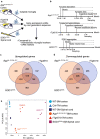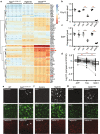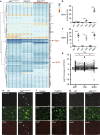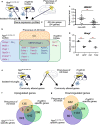Microglial gene signature reveals loss of homeostatic microglia associated with neurodegeneration of Alzheimer's disease
- PMID: 33402227
- PMCID: PMC7786928
- DOI: 10.1186/s40478-020-01099-x
Microglial gene signature reveals loss of homeostatic microglia associated with neurodegeneration of Alzheimer's disease
Abstract
Microglia-mediated neuroinflammation has been implicated in the pathogenesis of Alzheimer's disease (AD). Although microglia in aging and neurodegenerative disease model mice show a loss of homeostatic phenotype and activation of disease-associated microglia (DAM), a correlation between those phenotypes and the degree of neuronal cell loss has not been clarified. In this study, we performed RNA sequencing of microglia isolated from three representative neurodegenerative mouse models, AppNL-G-F/NL-G-F with amyloid pathology, rTg4510 with tauopathy, and SOD1G93A with motor neuron disease by magnetic activated cell sorting. In parallel, gene expression patterns of the human precuneus with early Alzheimer's change (n = 11) and control brain (n = 14) were also analyzed by RNA sequencing. We found that a substantial reduction of homeostatic microglial genes in rTg4510 and SOD1G93A microglia, whereas DAM genes were uniformly upregulated in all mouse models. The reduction of homeostatic microglial genes was correlated with the degree of neuronal cell loss. In human precuneus with early AD pathology, reduced expression of genes related to microglia- and oligodendrocyte-specific markers was observed, although the expression of DAM genes was not upregulated. Our results implicate a loss of homeostatic microglial function in the progression of AD and other neurodegenerative diseases. Moreover, analyses of human precuneus also suggest loss of microglia and oligodendrocyte functions induced by early amyloid pathology in human.
Keywords: Alzheimer’s disease; Animal model; Microglia; Neuroinflammation; Next generation sequence; Precuneus.
Conflict of interest statement
The authors report no biomedical financial interests or potential conflicts of interest.
Figures






Similar articles
-
Identification and therapeutic modulation of a pro-inflammatory subset of disease-associated-microglia in Alzheimer's disease.Mol Neurodegener. 2018 May 21;13(1):24. doi: 10.1186/s13024-018-0254-8. Mol Neurodegener. 2018. PMID: 29784049 Free PMC article.
-
Fibrillar Aβ triggers microglial proteome alterations and dysfunction in Alzheimer mouse models.Elife. 2020 Jun 8;9:e54083. doi: 10.7554/eLife.54083. Elife. 2020. PMID: 32510331 Free PMC article.
-
Microglial cannabinoid receptor type II stimulation improves cognitive impairment and neuroinflammation in Alzheimer's disease mice by controlling astrocyte activation.Cell Death Dis. 2024 Nov 26;15(11):858. doi: 10.1038/s41419-024-07249-6. Cell Death Dis. 2024. PMID: 39587077 Free PMC article.
-
Neuroinflammation in Alzheimer's disease: microglial signature and their relevance to disease.Inflamm Regen. 2023 May 10;43(1):26. doi: 10.1186/s41232-023-00277-3. Inflamm Regen. 2023. PMID: 37165437 Free PMC article. Review.
-
Microglia in Alzheimer's disease at single-cell level. Are there common patterns in humans and mice?J Exp Med. 2021 Sep 6;218(9):e20202717. doi: 10.1084/jem.20202717. Epub 2021 Jul 22. J Exp Med. 2021. PMID: 34292312 Free PMC article. Review.
Cited by
-
All roads lead to heterogeneity: The complex involvement of astrocytes and microglia in the pathogenesis of Alzheimer's disease.Front Cell Neurosci. 2022 Aug 12;16:932572. doi: 10.3389/fncel.2022.932572. eCollection 2022. Front Cell Neurosci. 2022. PMID: 36035256 Free PMC article. Review.
-
Genetic background variation impacts microglial heterogeneity and disease progression in amyotrophic lateral sclerosis model mice.iScience. 2024 Jan 11;27(2):108872. doi: 10.1016/j.isci.2024.108872. eCollection 2024 Feb 16. iScience. 2024. PMID: 38318390 Free PMC article.
-
Identification of female-enriched and disease-associated microglia (FDAMic) contributes to sexual dimorphism in late-onset Alzheimer's disease.J Neuroinflammation. 2024 Jan 4;21(1):1. doi: 10.1186/s12974-023-02987-4. J Neuroinflammation. 2024. PMID: 38178204 Free PMC article.
-
Genome-wide identification of murine interferon genes in microglial-mediated neuroinflammation in Alzheimer's disease.J Neuroimmunol. 2023 Feb 15;375:578031. doi: 10.1016/j.jneuroim.2023.578031. Epub 2023 Jan 21. J Neuroimmunol. 2023. PMID: 36708632 Free PMC article.
-
Multivariate investigation of aging in mouse models expressing the Alzheimer's protective APOE2 allele: integrating cognitive metrics, brain imaging, and blood transcriptomics.Brain Struct Funct. 2024 Jan;229(1):231-249. doi: 10.1007/s00429-023-02731-x. Epub 2023 Dec 13. Brain Struct Funct. 2024. PMID: 38091051 Free PMC article.
References
-
- Benjamini Y, Hochberg Y. Controlling the false discovery rate: a practical and powerful approach to multiple testing. J R Stat Soc Ser B. 1995;57:289–300. doi: 10.2307/2346101. - DOI
-
- Castillo E, Leon J, Mazzei G, Abolhassani N, Haruyama N, Saito T, Saido T, Hokama M, Iwaki T, Ohara T, et al. Comparative profiling of cortical gene expression in Alzheimer’s disease patients and mouse models demonstrates a link between amyloidosis and neuroinflammation. Sci Rep. 2017;7:17762. doi: 10.1038/s41598-017-17999-3. - DOI - PMC - PubMed
Publication types
MeSH terms
Substances
LinkOut - more resources
Full Text Sources
Other Literature Sources
Medical
Molecular Biology Databases
Miscellaneous

